Nebraska is a strange state when it comes to rocks and gems. There are almost no gemstones found in the state, but it actually has a wide range of different silicified fossils and a ton of different types of agate nodules spread across the region. The state may not have the best selection, but there’s enough there to keep a rockhound occupied for a while.
Let’s dig in and take a look at some of the rocks, minerals, and gemstones found in Nebraska!
1. Agate/Jasper
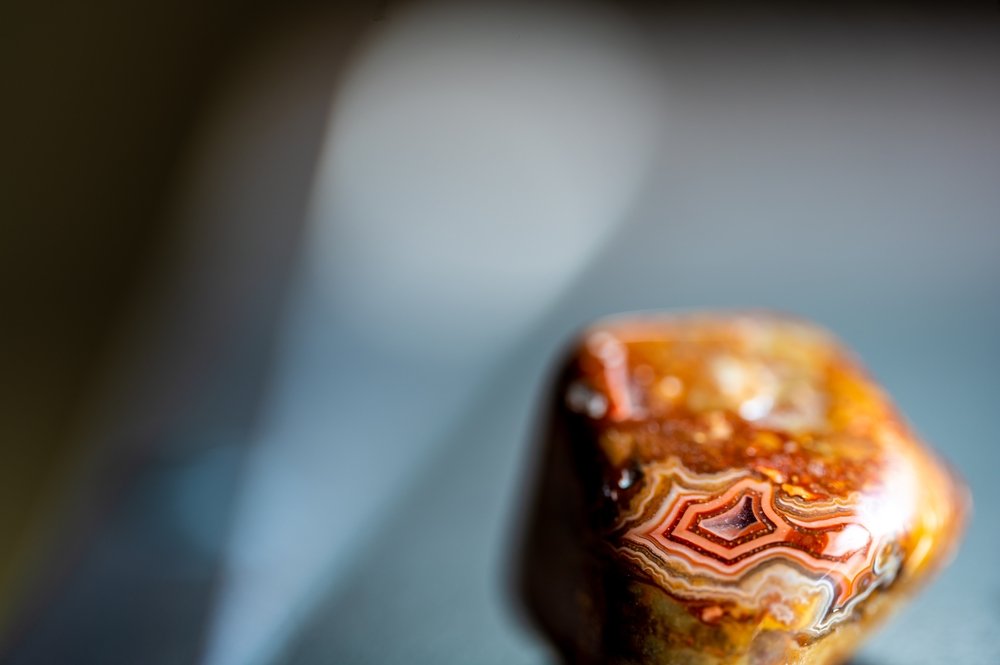
Agate and jasper are two sides of the same coin. Both are chalcedony-based stones, a complex cryptocrystalline mixture of quartz and moganite. This leaves them feeling smooth to the touch with almost no crystal grains visible even under a microscope. Agates are generally banded but always translucent, while jasper is an opaque, patterned variety of chalcedony.
The agates in Nebraska are some of the most desirable types. In various places across the state you can find banded and moss agates. The most exciting of the former is the famous Fairburn agates found in the Northwestern portion of the state. These agates feature complex and interrupted banding and often show red and black coloration.
Jaspers from this state tend to be simple and earth tones. There are some pastel variants and the ever-present red and yellow sort as well. The latter are sometimes brecciated, revealing awesome patterns when they’ve been cut open.
All of these can be found across the state in waterways and gravel pits. There are few areas in the US where you’re too far from a good spot for agates or jaspers after all.
Some of the more well-known locations include the following:
- Dawes County
- Republican River between Franklin and McCook
- The Whiteclay River
- Federal grazing lands near Crawford
This is just the beginning of where you can look, although the latter area tends to host Fairburns which aren’t found in other places.
One further note: unlike many states, Nebraska’s collectible stones are spread across the entire state. All stones on this list can be found in most of the same places unless otherwise indicated.
2. Blue Lace Chalcedony
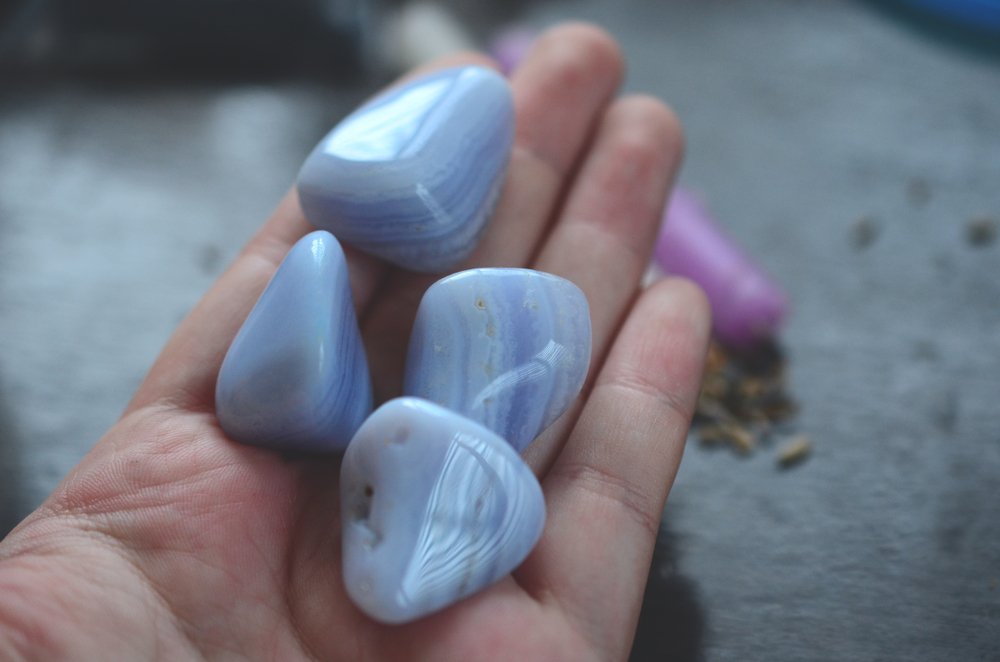
Blue lace chalcedony is often simply called “chalcedony” due to how common it is. Chalcedony itself is a translucent cryptocrystalline silica-based stone. The term is usually used for solid-colored variations or at least those that lack the banding or inclusions that typify agates. In Nebraska, there are some great samples of this form of chalcedony.
It occurs both inside geodes and in botryoidal masses. These masses are made up of spheres of light blue material that are melded together. When cut there may be some light banding. In geodes, it’s typically found on the interior portion before macrocrystalline quartz springs into the center of the cavity. You’ll also see this stone referred to as “blue agate”, particularly in geodes where banding is almost always present.
This stone can be quite valuable. The sky blue color lends itself well to use in jewelry and cabochons of high-grade material are highly sought after. The color saturation of Nebraska samples is quite good in most cases. You may also find smaller nodules of colorless chalcedony on occasion in the same places where you find agates and jaspers.
This blue form of chalcedony is found in Dawes County near Crawford. The area also hosts strange specimens of colorless chalcedony that look more like bladed crystals than the normal rounded mass.
3. Opalized Wood
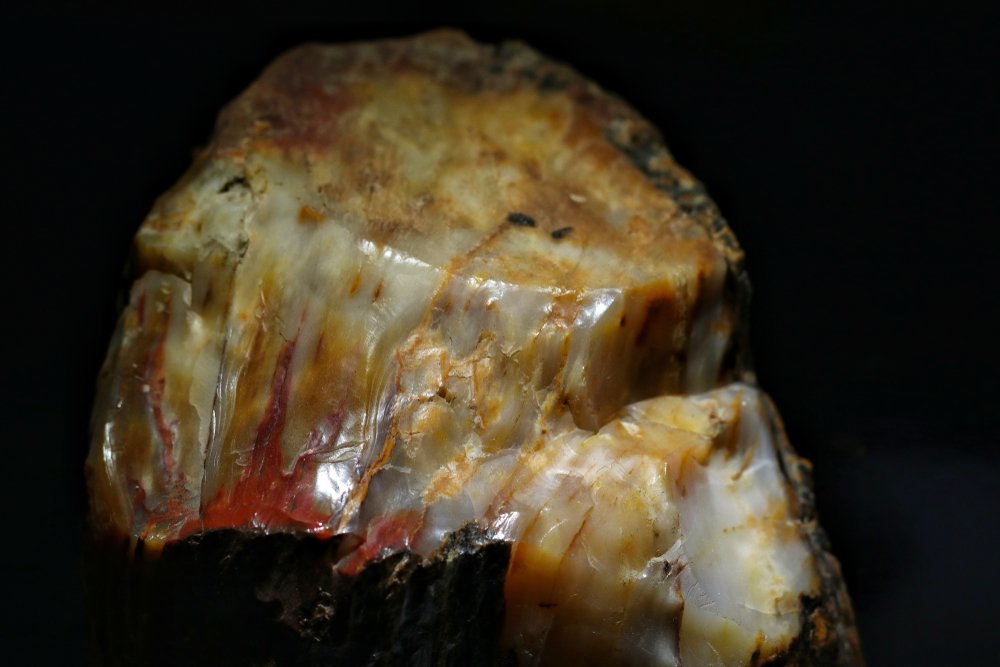
Opalized wood is a form of petrified wood. In this case, the wood has been replaced with amorphous silica comprised of rounded spheres stacked on top of each other. Opal differs from chalcedony/agate due to its glass-like structure and much higher moisture content than that found in chalcedony variants or quartz.
Not all opal is the precious variety. Indeed, opal with internal fire is exceedingly rare while opal itself… is not. Common opal, sometimes called potch, is solid colored and has a waxy surface texture. It carves readily and takes a great polish, making it a favorite for lapidary work. I’d be remiss to note that opal is my favorite stone for carving. While vulnerable to thermal shock it carves quicker than chalcedony but still takes an incredible surface polish.
Opalized wood is a fossil. Over time decaying plant matter held deep underground is replaced with a silica-rich gel that undergoes further changes due to the pressure and heat of the Earth itself. The resulting stone will completely fill the place where the wood decayed, creating a pseudomorph of opal or agate as the case may be.
Opalized wood can be found in the same places that you’d search for agate and jasper. Waterways and gravel pits are your best bet. Alongside the opalized wood, you’ll also find another form of ancient pseudomorph.
4. Agatized Wood
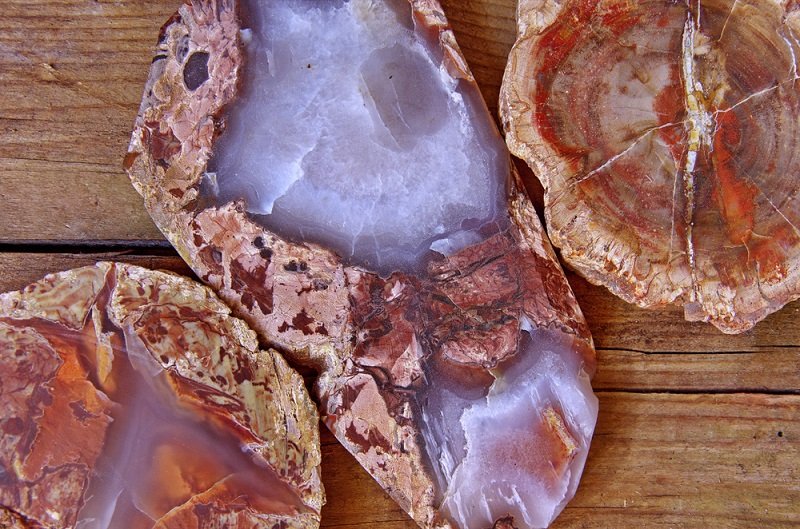
Agatized petrified wood is the most common type of petrified wood in most locations. It varies greatly depending on its original structure and the minerals that surround it. Agatized wood ranges from rough browns to bright greens depending on the location it’s found in. There are even the complex internal rainbows of the Arizona petrified conifers included in this category.
Agatized wood is often intermixed with opalized wood. You can tell the difference easily enough: a steel knife will scratch opal but not agate. This makes it easy to differentiate between the two and to tell if the cool piece of petrified wood you found is one or the other. Many pieces will have sections of both minerals, often with the opalized material closer to the center of the cast.
Nebraska petrified wood is usually a brown color. There are also some much more impressive samples of blue petrified wood in the state, however. These woods range from an opalized white mass with blue tendrils to actually being a very dark blue in color.
Agatized wood is found alongside agate and jasper all over the state, but the best examples come from Harlan County and Dawes County. The latter is often the source of spectacular blue petrified wood and would be my first choice to take a look.
5. Geodes
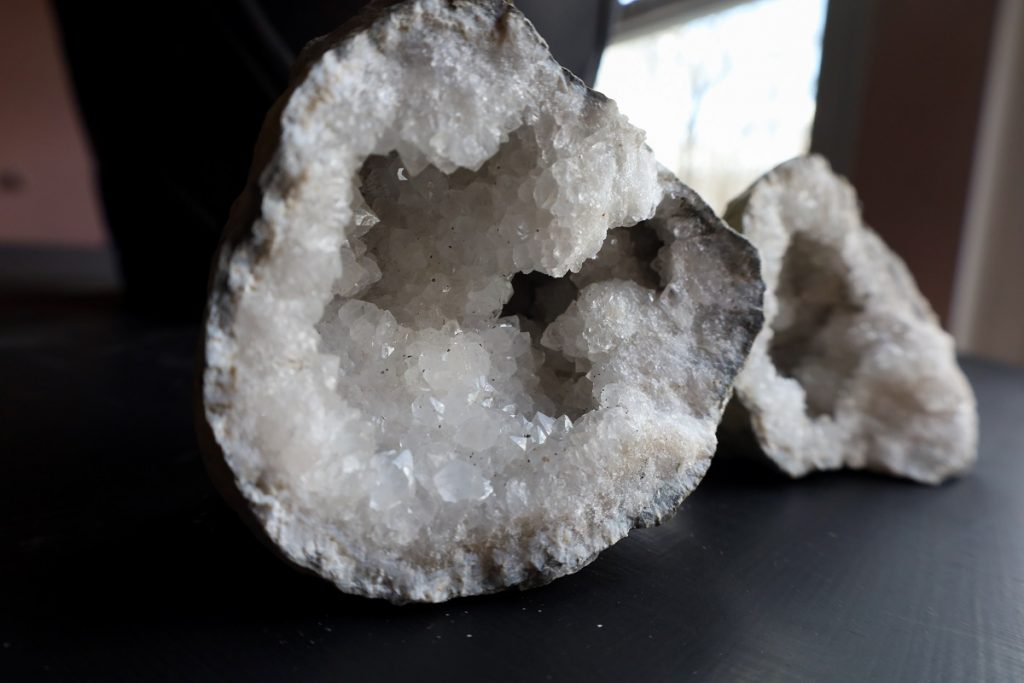
Geodes aren’t a mineral themselves, instead, they’re a form of different minerals. They’re often collected on their own merit, and most of the minerals that occur inside of them also occur in other forms. Geodes are hollow rocks that has crystallized minerals contained in the interior, often quartz or calcite.
Geodes are an ancient formation. They occur in igneous stone where bubbles dried in ancient magma before being filled with silica-rich waters. These slowly metamorph into crystals over a few million years, creating the geodes that we know and love. They’re one of the most commonly sought-after stones, the idea of something beautiful hidden in a plain rock is noteworthy.
The most common geodes found in Nebraska are based in either quartz or chalcedony. Quartz geodes have crystal-lined interiors. Those based on chalcedony will simply display a botryoidal interior. The chalcedony may also have a fine coating of druzy quartz covering it in the case of older geodes.
Like many of the stones in this state, geodes are spread far and wide. They appear to be more common in gravel pits than in waterways. Those looking for the rarer celestite geodes would be best served in the gravel pits of Dawes County and Sioux County.
6. Quartz
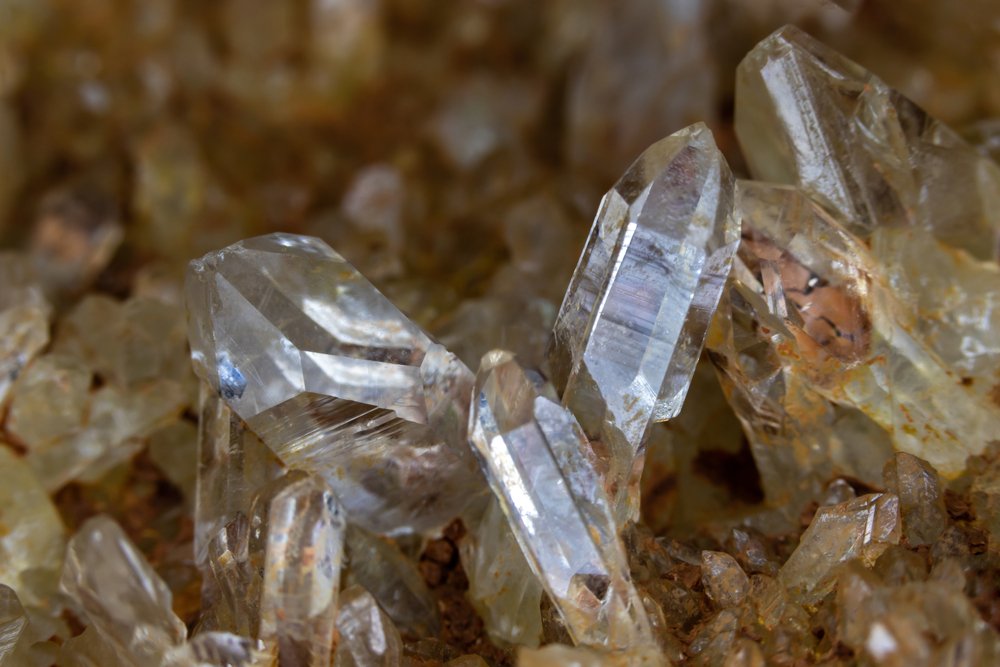
Quartz is an iconic crystal, one of the few that are known well to the general public. It’s a pure form of silica, creating a clear, hexagonal crystal that’s usually only terminated on one end. Quartz is common, it’s the variety and quality that vary from location to location. In Nebraska almost all of it will have come from geodes, even clusters are most likely simply broken bits of a larger hollow that was filled with crystals.
Quartz has many varieties, ranging from amethyst to more exotic variants like fire quartz. Some are included while others are colored by the placement of iron ions in the crystalline matrix of the silica. These latter result in the most common types which include citrine, amethyst, and prasiolite.
The best crystals in Nebraska will always come from geodes. Loose pieces in waterways tend to get worn down over time, leaving one with simply a white, barely translucent piece of crystal. These quartz cobbles usually lack any indication of form as well.
Quartz can be found all around the state, in the same areas as most of the other stones listed.
7. Celestite
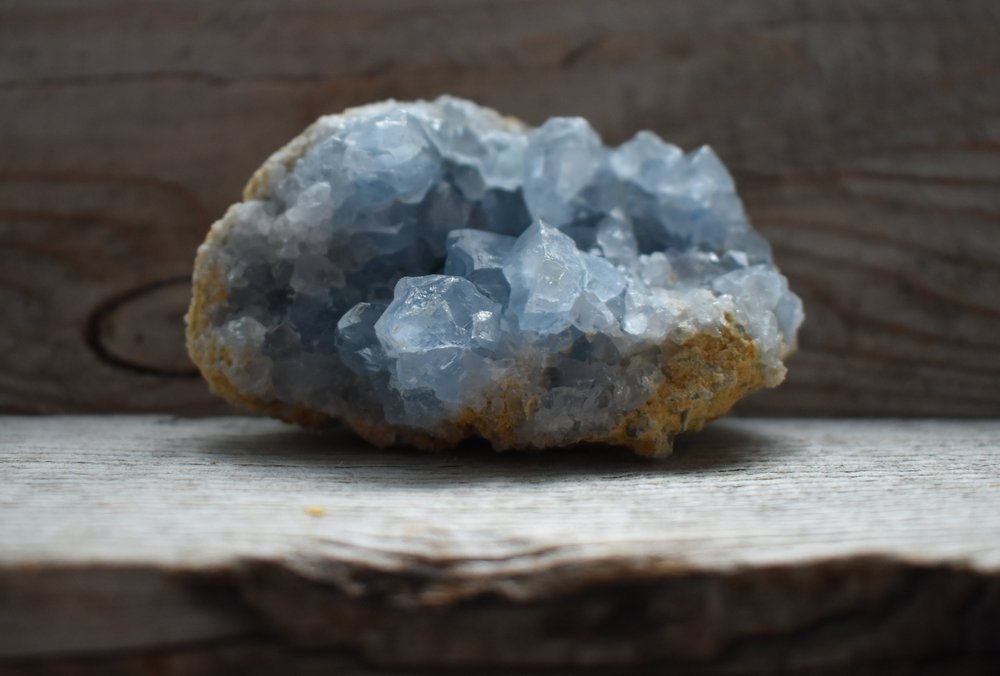
Celestite is a light blue crystalline mineral. Chemically it’s strontium sulfate, and it remains an important source of strontium in many areas. You’ll see it referred to as celestine as well as celestite, depending on the source. It’s a favorite crystal for many collectors, the light blue coloration is attractive and it’s quite distinct from other light blue minerals like lace chalcedony.
It occurs in a wide variety of forms. The most highly sought-after are light blue crystals which are well formed. These often have incredible clarity. There are also tabular and massive formations of celestite. Celestite is often found in geodes, and one of the largest geodes in the world is actually filled with this mineral.
Celestite from Nebraska can be very high quality. It will usually be found in geode form as the crystals frequently break off when broken chunks of geodes end up in waterways and pits. Unlike most of the minerals of Nebraska, celestite is found in only a few choice locations so you may need to travel a bit.
Celestite geodes and broken pieces can be found in the following areas:
- Otoe Creek in Gauge County
- Near Fullerton
- Near Hay Springs
It’s a rare mineral, but it’s worth a look. Celestine geodes are an incredible find, especially since you won’t need to go hard rock digging to find them.
8. Calcite
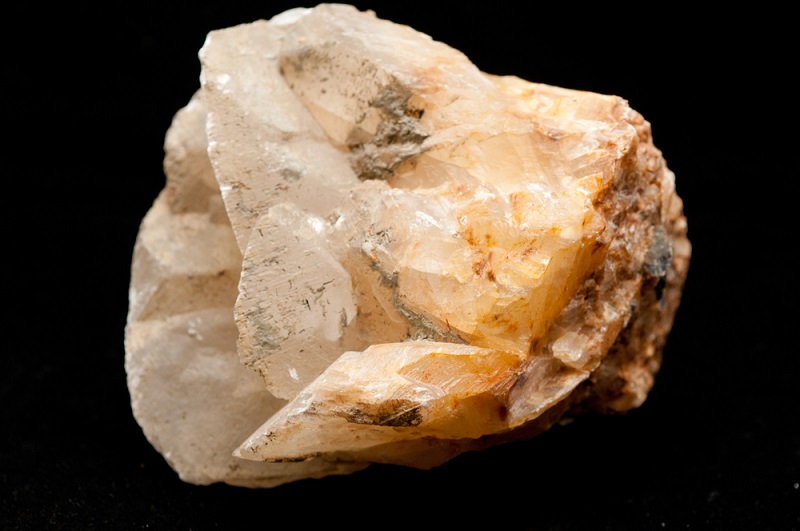
Calcite is another common mineral with a wide variety of different forms. It’s most often seen as a white dusting on other minerals, simple formations of dried-out calcium carbonate. That’s not the kind collectors are looking for and it often ends up being taken off of specimens with acids. The acid can be as weak as vinegar due to the nature of calcite.
Instead, we look for the crystalline form. This comes in a huge variety of different colors, often with varying levels of UV reactivity. They can be found in most states to some degree, often in the form of geodes. In other cases, crystals form in different types of bedrock. These are often blessed with surprising clarity.
The majority of the material that comes out of Nebraska is clear or white calcite. Boring at first glance, UV light reveals another property of these stones: fluorescence. Under short wave UV light, the calcite from Nebraska often shows a wide variety of different colors. One of the most prized is the so-called “watermelon calcite.” This nondescript white calcite glows bright green and pink under UV light, looking like an electric version of its namesake fruit.
This is another mineral that you’ll need to track down in specific locations. The following areas are known to hold it:
- The area around Lincoln
- Cass County
- Gage County
These stones aren’t super rare, but they only show up in the northwest and southeast portions of the state. It’s worth a look if you’re passing by!
- Online rock and mineral club for collectors of all levels!
- Find community with like-minded rock and mineral enthusiasts.
- Monthly Giveaways!
- Free Access to Entire Digital Library of Products (current and future products)*


